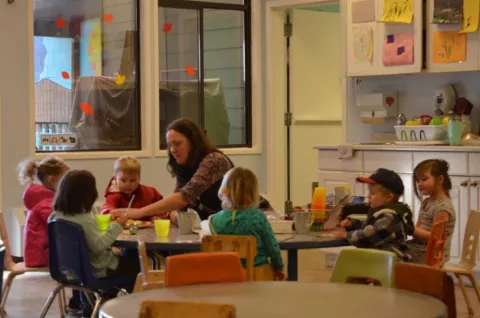
Creativity and curiosity thrive at Nanaimo CDC expanded preschool

When the Nanaimo Child Development Center (CDC) opened over 50 years ago, the preschool was one of its first community programs, said HSA member Kathleen Silvey.
Silvey, who started at the Nanaimo CDC as an early childhood educator nearly 28 years ago, works as the department leader for the preschool. She does program planning and works with staff to deliver the curriculum. She facilitates inclusion practices for kids with special needs.
Silvey finds working with young children very rewarding. “There’s so much promise when you’re working with little people and their families,” she said. “You get to be a part of their world and be witness to their learning and their growth.”
In the summer of 2019, building renovations started to allow for an expansion of the program. The program size increased by 33 per cent, from 60 to 80 spaces. 12 of these spaces are set aside for children with special needs.
“We’ve been very well received,” said Silvey. “We have families that are quite happy with the new space we’re in. The space is lovely - we’re very blessed.”
In July 2017, staff at the Nanaimo CDC became members of HSA after voting in favour of joining the union. Unionization triggered a program review, and Silvey worked closely with management, including the CDC’s Executive Director Dominic Rockall, Program Director Cheryl Booth, and Finance and Human Resources Director Judy Gallacher, to brainstorm how the preschool would continue its operations in a sustainable way.
“The union encourages us to be lateral thinkers and be creative, and Kathleen is a very creative leader in her department,” said Chief Steward Ellie Wray.
“We all worked together. It was a group effort. It really speaks to the value the centre places on the preschool, and that is hugely appreciated,” said Silvey.
According to Silvey, the board of directors was also supportive of new, creative approaches to operating the centre.
It was through this collaborative effort that the idea to renovate the preschool sprouted, to allow for increased enrollment.
“We already had the staffing in place, so we just needed more space,” said Silvey. By renovating the preschool classroom, the centre has been able to increase preschool spaces without a major cost to families.
Silvey said that the preschool is the only program at the centre completely funded by user fees.
“However, if parents are eligible, they can access the Affordable Child Care Benefit,” she added.
The Affordable Child Care Benefit (ACCB) was introduced by the NDP government in September 2018 and can save eligible families up to $15,000 per year on childcare costs. Any family whose pre-tax income is less than $111,000 qualifies for the ACCB. Since introducing its affordable childcare plan – which the government says marks the largest investment in childcare in BC’s history – more than 10,000 new licensed childcare spaces have been created across the province.
“It’s been hugely beneficial for families. We’re thrilled to see that happen,” said Silvey about the ACCB. She said that with an increase in the number of families eligible for support, it’s now easier for them to access a quality preschool.
Best practices in early childhood programming
The preschool program is based on BC’s recently updated Early Learning Framework. “We’ve always followed the Early Learning Framework to some degree, but now it’s like our bible,” said Silvey.
She said the centre’s staff appreciate this year’s revisions to the framework.
The new framework has an increased focus on inclusive practices, reconciliation, and Indigenous worldviews, according to the Government of BC website. It was developed collaboratively with ECEs, primary teachers, Indigenous organizations, elders, and the academic community.
Within that, Silvey said the preschool subscribes to a philosophy of practice called emergent curriculum.
“Emergent curriculum is a way of being responsive to children’s interests,” explained Silvey.
“We focus on following the child’s lead and embedding the learning within those interests,” she said. “It’s about opening up all of the interesting things that are in the world as the kids are experiencing it.”
Silvey said that the preschool has also been working to deliver Reggio Emilia-inspired programming. Reggio Emilia, named after the city in Italy where it was developed, is an educational model that emerged following World War II, and seeks to build respect for others.
“Their school system and their early childhood programs are seen as some of the best in the world,” said Silvey.
Reggio Emilia operates from the principle that all children are full of potential and are innately curious and creative. It is child-centred, instead of a one-size-fits-all approach.
Silvey said that the organization has been very supportive of the preschool in implementing Reggio Emilia-inspired programming.
“It’s a journey, and it’s a new learning. It fits hand and glove with the Early Learning Framework, and it’s seen as best practice and progressive,” said Silvey.
These programming elements, combined with the preschool’s connection to the CDC, has resulted in major benefits for families.
“The CDC itself has a very high standard of evidence-based practice and best practice when it comes to providing service to kids and families,” said Silvey. “There is a layer of support that is hugely valuable to us.”
Silvey says that by operating under the same roof as the CDC, the preschool has access to great resources from the different departments alongside them.
This support was made evident when, just after Thanksgiving, the preschool got the go-ahead to move into the newly renovated space.
“We put an announcement over the intercom asking anyone who is available to help the preschool move, to come and join us,” recounted Silvey.
“The whole centre came together and moved us down the hall into our new space. It was really lovely, it was a community effort,” she said.
“We are well loved and we feel it.”
This article originally appeared in the December 2019 issue of HSA's magazine The Report. To read the full issue, click here.